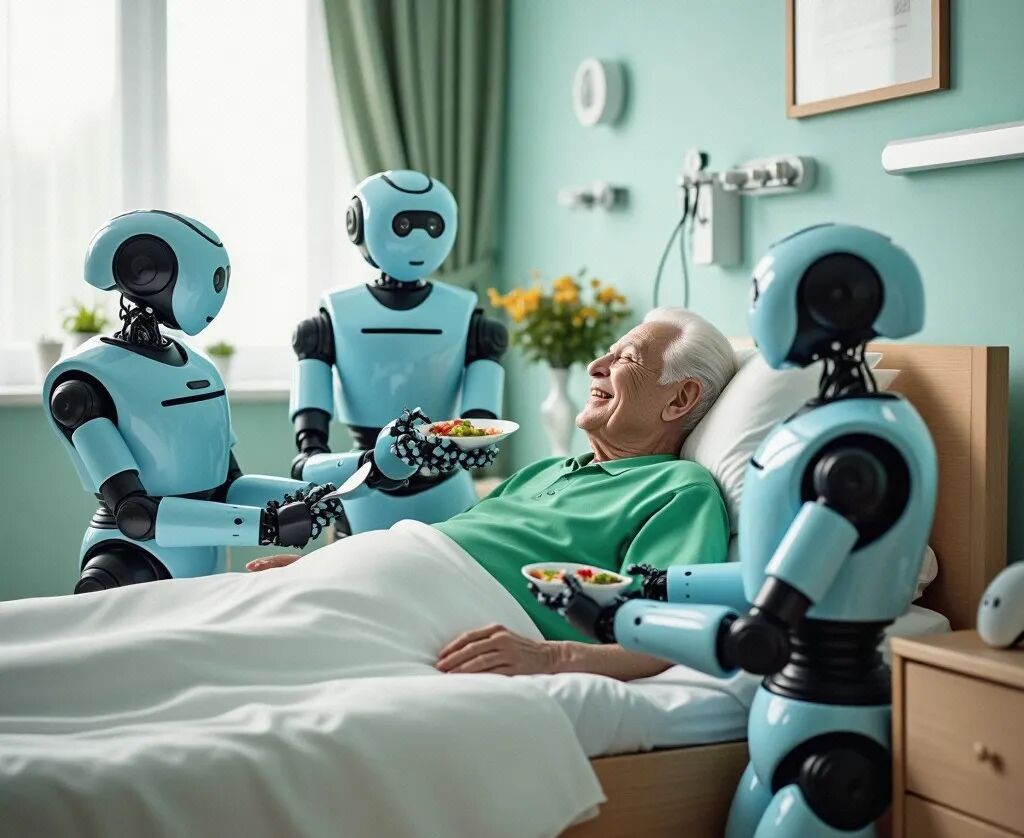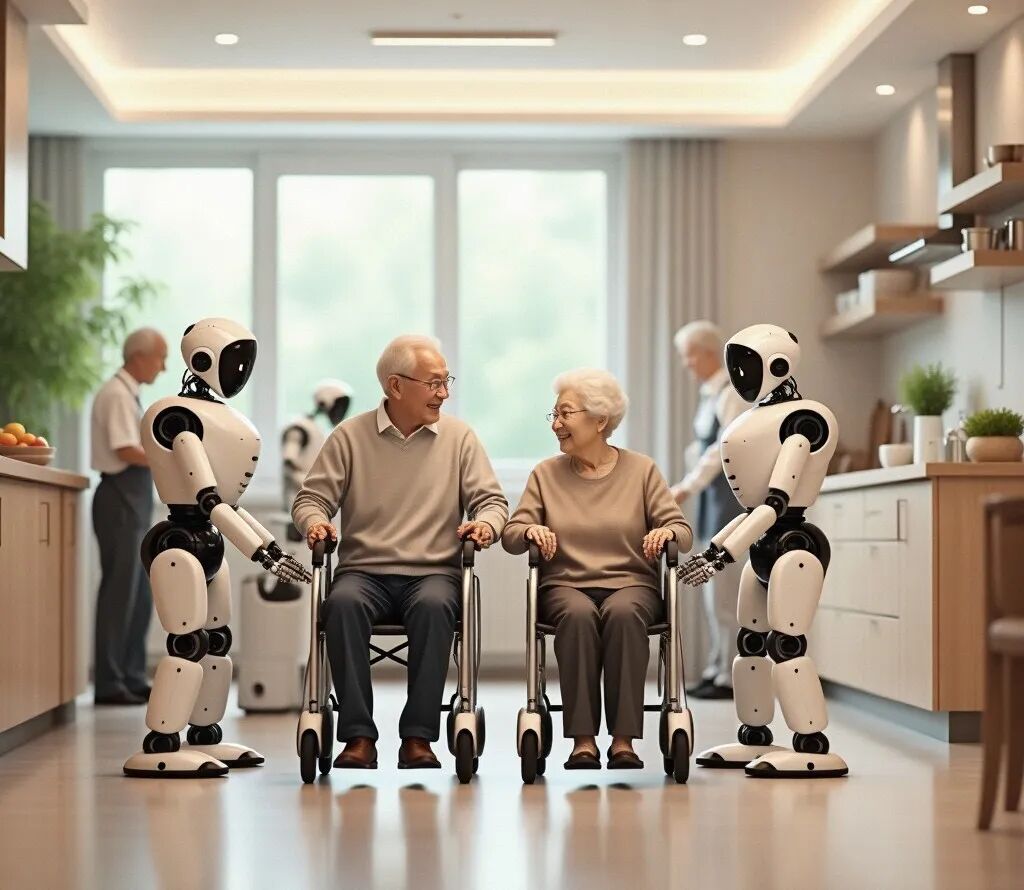Behind the spotlight of capital’s enthusiasm for humanoid robots, a group of steel caregivers is quietly initiating a revolution in nursing homes and family settings.
As Tesla’s Optimus completes squat training in the lab and tech giants rush to enter the humanoid robot race, another industrial evolution concerning the dignity of 300 million elderly people in China is quietly taking place in nursing beds, bathing rooms, and community activity centers. This revolution does not chase flashy stage performances but reconstructs the daily life of “the elderly having support” with sensors and algorithms.

1. Tsunami of Demand: A Care Vacuum Created by One New Disabled Elderly Person Every 1.5 Seconds
China is entering deep aging at a rate of 10 new elderly people over 60 every minute. Behind the cold numbers is a care cliff built by a shortage of 5.5 million nursing caregivers:
- In a nursing community in Chengdu, 80% of disabled elderly people require walking support an average of 4 times a day
- In a nursing home in Shenzhen, each caregiver serves an average of 8 disabled elderly people, with a nighttime response delay of over 20 minutes
- Lonely elderly people engage in fewer than 10 conversations a day, leading to emotional desolation and increased risk of depression
This care crisis is forcing technological evolution. Unlike humanoid robots that pursue “universal applicability in all scenarios,” elderly care robots choose to exploit vertical scenarios: from incontinence care and gait training to emotional companionship, each segmented need is an entry point into a trillion-dollar market.
2. Steel Bones and Gentle Hearts: These “Clumsy” Machines are Reshaping Daily Elderly Care
In a rehabilitation center in Qingdao, a lower limb walking robot is helping Aunt Liu walk out of a room she has been trapped in for 6 years. Through gait training algorithms, the machine calculates the required force for each step in real-time, tripling rehabilitation efficiency. These seemingly heavy devices have become the “steel exoskeleton” for 85 million elderly people with physical disabilities.
A more subtle revolution is happening in the restroom. The introduction of incontinence care robots in a nursing home in Shenzhen can initiate a cleaning program within 1 second, reducing the daily use of diapers from 5 to 1. For disabled elderly people with a fragile sense of dignity, this contactless care is nothing short of a spiritual liberation.
Meanwhile, Uncle He in Chengdu is experiencing another kind of warmth: when he forgets where his coat is, the companion robot not only reminds him of the storage location but also notifies his children via mobile phone. These multimodal interactive devices are filling the memory gaps of 30 million Alzheimer’s patients.
3. A Tale of Two Extremes: The Technological Long March in a Trillion-Dollar Blue Ocean
Despite the explosive demand, elderly care robots still need to overcome three major hurdles to truly “fly into ordinary households”:
① The Deep Waters of Technical Adaptation
- The existing product language understanding error rate is 37%, making it difficult to capture the vague expressions of elderly people
- The mechanical arms of bathing robots lack flexibility, with water temperature control accuracy of only ±3℃
- The false alarm rate for fall warnings from health monitoring carpets is as high as 28%
② The Gap in Cost and Awareness
- High-end rehabilitation equipment costs over 500,000 yuan, enough to pay for a caregiver’s salary for 10 years
- 72% of children only know about cameras or wristbands, with a blank understanding of smart care devices
③ The Fog of Missing Standards
- The same walking aid has a measurement error of up to 41% across different institutions
- The privacy data boundaries of emotional companionship robots have yet to be clearly legislated

4. The Path to Breakthrough: Leasing Models and Ecological Reconstruction
In the face of challenges, pioneers are exploring Chinese-style solutions:
- Breaking the Ice with Shared Economy: Guangzhou is piloting community walking aid rental cabinets, reducing the cost of single use to 8 yuan
- Closed Loop of Industry, Academia, and Research: Shenzhen tech companies are collaborating with universities to establish an Elderly Care Robot Academy, training 3,000 composite nursing talents annually
- Migration from the Automotive Industry: A certain new energy vehicle company has transplanted battery thermal management technology to bathing robots, reducing energy consumption by 40%
On the policy front, the IEC63310 international standard led by China has defined the runway for the industry, while the 10 billion yuan robot industry fund established in Beijing is catalyzing the domestic replacement of core components.
5. Future Vision: A Silver Age of Human-Robot Symbiosis
While humanoid robots are still working on “can they brew tea autonomously,” elderly care robots have already built a three-tier service ecosystem:
| Service Level | Robot Replacement Rate | Human Value |
|---|---|---|
| Basic Care | 72% | Quality Supervision, Emergency Intervention |
| Rehabilitation Training | 58% | Program Development, Psychological Motivation |
| Emotional Companionship | 35% | Deep Empathy, Value Restructuring |
This gradual replacement is not about cold machines replacing humans, but about allowing artificial intelligence to amplify human warmth. Just like the “memory puzzle” activity conducted in Chengdu nursing communities: robots are responsible for selecting old photos to generate puzzle modules, while human volunteers guide the elderly to tell the stories behind the photos—technology solves efficiency, while humanity safeguards dignity.
The ultimate goodwill of technology lies not in creating perfect substitutes. While we marvel at humanoid robots that can dance, we should also see those silent steel caregivers: they may not be as flashy, but they are weaving a safety net made of sensors in the lives of 300 million elderly people in China. This net supports not only aging bodies but also the dignity that every life deserves at its end.
In the next 5 years, as the cost of sodium batteries decreases by 40% and multimodal large models mature, elderly care robots will complete their transformation from “functional machines” to “intelligent agents.” But more important than technological breakthroughs is whether we can retain the warmth of humanity in algorithms—after all, while robots can remember the birthdays of elderly people’s grandchildren, it is always humans who shed tears upon hearing this news.

